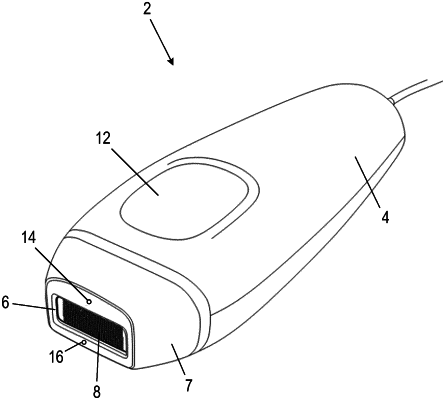| CPC A61B 18/20 (2013.01) [A61B 5/0531 (2013.01); A61B 5/441 (2013.01); A61B 2018/00476 (2013.01); A61B 2018/00648 (2013.01); A61B 2018/00797 (2013.01); A61B 2018/00875 (2013.01); A61B 2018/00904 (2013.01); A61B 2018/00922 (2013.01); A61B 2018/202 (2013.01)] | 20 Claims |

|
1. A handheld device for applying energy pulses to skin of a subject to perform a treatment operation as the handheld device is moved across the skin, the handheld device comprising:
an aperture that is to be placed adjacent to the skin,
at least one energy source for generating energy pulses and for providing the energy pulses through the aperture to perform the treatment operation on skin adjacent the aperture, wherein the at least one energy source has a minimum pulse repetition period following the generation of an energy pulse before a subsequent energy pulse can be generated;
a first skin property sensor for measuring a skin property and for outputting a first measurement signal representing measurements of the skin property at a first sensing position, wherein the skin property is a property that changes in response to application of an energy pulse to the skin, and wherein the first sensing position is in front of the aperture relative to an intended motion direction of the handheld device over the skin;
a second skin property sensor for measuring the skin property and for outputting a second measurement signal representing measurements of the skin property at a second sensing position, wherein the second sensing position is behind the aperture relative to the intended motion direction, and wherein each of the first skin property sensor and the second skin property sensor is a temperature sensor, an optical sensor, an acoustic sensor or an electrical sensor;
a memory unit; and
a control unit that is coupled to the at least one energy source to control the generation of the energy pulses by the at least one energy source, and coupled to the first skin property sensor and the second skin property sensor to obtain the first measurement signal and the second measurement signal, respectively, wherein the control unit is configured to store a profile of at least the first measurement signal in the memory unit;
wherein the control unit is further configured to, when the handheld device is moving in the intended motion direction over the skin:
analyze the profile of the first measurement signal to determine if the first skin property sensor is passing over a previously treated area of skin;
on detecting that the first skin property sensor is not passing over a previously treated area of skin, control the at least one energy source to generate an energy pulse when the minimum pulse repetition period following generation of a previous energy pulse has expired;
on detecting that the first skin property sensor is passing over a previously treated area of skin, perform consecutive operations comprising:
preventing generation of an energy pulse, even if the minimum pulse repetition period following the generation of a previous energy pulse has expired;
marking a point in the profile of the first measurement signal stored in the memory unit, wherein the marked point relates to a position on the previously treated area of skin;
using information about the marked point, analyze a profile of the second measurement signal to identify a similar marked point in the profile of the second measurement signal; and
on identifying the similar marked point in the profile of the second measurement signal, controlling the at least one energy source to generate an energy pulse when the minimum pulse repetition period following the generation of the previous energy pulse has expired.
|